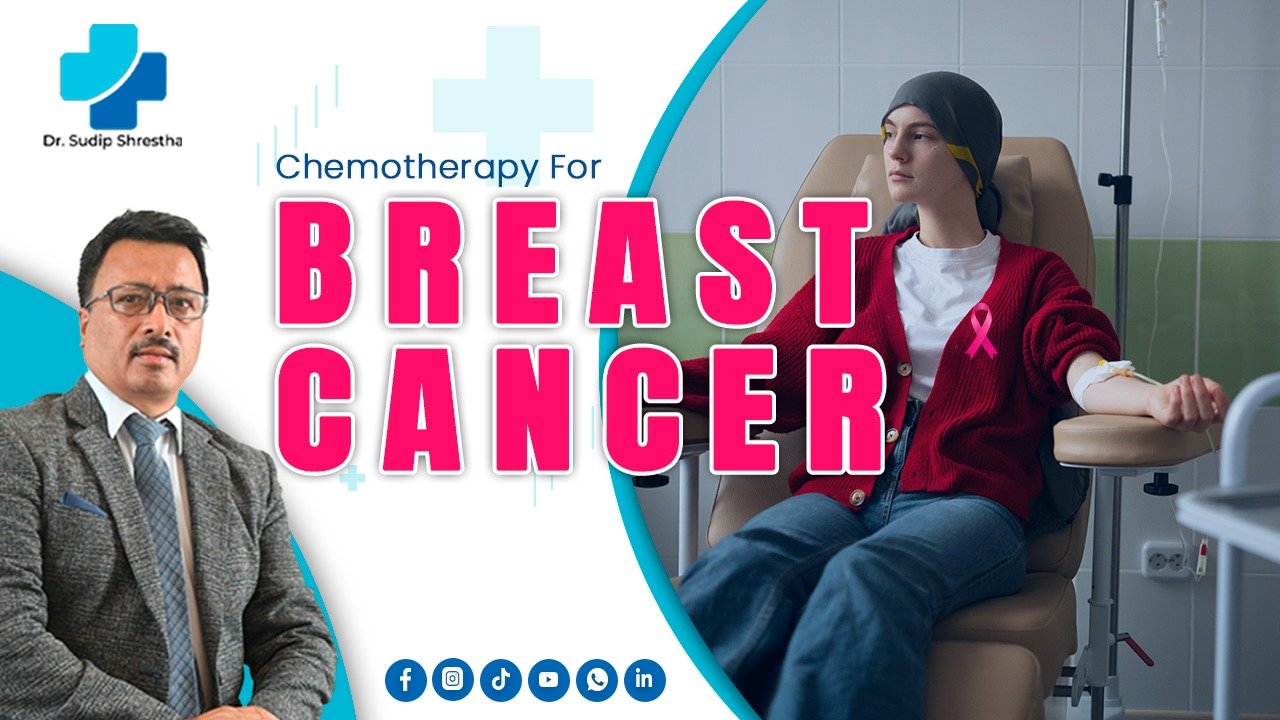I. Introduction
Breast cancer is one of the most prevalent forms of cancer worldwide, affecting millions of individuals each year. The treatment landscape for breast cancer has evolved significantly over the years, with various approaches designed to target the disease’s complexities. Among these treatment options, chemotherapy remains a vital component in the battle against breast cancer.
A. Definition of chemotherapy in breast cancer treatment
Chemotherapy, often simply referred to as “chemo,” is a widely recognized term in the realm of cancer treatment. In the context of breast cancer, chemotherapy involves the use of drugs to inhibit the growth and spread of cancer cells. These drugs are designed to disrupt the rapid division of cancer cells and can be administered through various routes, including intravenously or orally. While chemotherapy is an established and effective treatment for breast cancer, its application and impact are not uniform. Instead, they depend on several critical factors, such as the type and stage of breast cancer, individual patient characteristics, and recent advancements in the field of oncology.
B. Importance of personalized treatment
Personalized medicine has emerged as a revolutionary concept in cancer treatment, including breast cancer. It recognizes that each patient’s cancer is unique, driven by specific genetic and molecular alterations. Consequently, the one-size-fits-all approach to chemotherapy has given way to a more tailored and precise strategy. Personalized treatment seeks to identify these distinct characteristics, allowing healthcare professionals to select the most effective chemotherapy regimen for an individual patient. This approach not only maximizes the chances of treatment success but also minimizes unnecessary side effects, ultimately improving the patient’s quality of life during and after treatment.
C. Overview of the variations in chemotherapy for breast cancer
Breast cancer is a multifaceted disease with several subtypes, including estrogen receptor-positive (ER+), HER2-positive, and triple-negative breast cancer, among others. Each subtype presents unique challenges and opportunities for treatment. Therefore, the variations in chemotherapy for breast cancer are vast, with different drug combinations, dosages, and treatment durations tailored to the specific characteristics of the tumor.
II. Understanding Breast Cancer
Breast cancer is a complex and diverse group of diseases that affect the breast tissue. It is essential to understand its various aspects to make informed decisions about prevention, screening, and treatment. This section will explore the different types of breast cancer, the importance of staging and grading, and the significance of individualized treatment plans. Certainly, here is the requested content on understanding breast cancer:
A. Types of breast cancer
- 1. Invasive Ductal Carcinoma (IDC): This is the most common type of breast cancer, accounting for approximately 80% of all cases. IDC originates in the milk ducts of the breast and can spread to nearby tissues.
- 2. Invasive Lobular Carcinoma (ILC): ILC begins in the lobules (milk-producing glands) of the breast and can also spread to adjacent tissues. It is the second most common type of invasive breast cancer.
- 3. Ductal Carcinoma in Situ (DCIS): DCIS is a non-invasive cancer where abnormal cells are found in the lining of a breast duct but have not spread outside the duct. It is considered a precancerous condition.
- 4. Inflammatory Breast Cancer (IBC): IBC is a rare but aggressive form of breast cancer. It often presents with redness, swelling, and warmth in the breast, resembling an infection.
- 5. Triple-Negative Breast Cancer: This type lacks receptors for estrogen, progesterone, and HER2/neu. It can be more challenging to treat because it doesn’t respond to hormone-based therapies.
- 6. HER2-Positive Breast Cancer: HER2-positive tumors have an excess of a protein called HER2/neu, making them more aggressive. Targeted therapies, such as Herceptin, are effective against this type.
B. Staging and grading:
Staging and grading are crucial aspects of understanding the extent and aggressiveness of breast cancer:
- 1. Staging: Staging determines the size of the tumor, whether it has spread to nearby lymph nodes, and if it has metastasized (spread to distant organs). The most common staging system used is the TNM system (Tumor, Node, Metastasis).
- 2. Grading: Grading assesses the appearance and behavior of cancer cells under a microscope. It helps predict how quickly the cancer may grow and spread. The most widely used grading system is the Nottingham Grading System, which assigns a grade based on the structure and arrangement of cancer cells.
C. Importance of individualized treatment plans:
Breast cancer treatment is not one-size-fits-all. The key to successful outcomes is developing an individualized treatment plan that considers several factors:
- 1. Type and Stage: Treatment decisions depend on the specific type and stage of breast cancer. Some may require surgery, while others may need chemotherapy, radiation therapy, or a combination of treatments.
- 2. Tumor Biology: Genetic testing can reveal specific mutations or biomarkers in the tumor, guiding targeted therapies designed to attack cancer cells with precision.
- 3. Patient’s Health and Preferences: A patient’s overall health, age, and personal preferences play a role in treatment decisions. Some treatments may be more suitable based on an individual’s unique circumstances.
- 4. Clinical Trials: Participating in clinical trials can offer access to cutting-edge treatments and therapies not yet widely available.
III. Factors Influencing Chemotherapy Variation
Chemotherapy is a cornerstone in the treatment of cancer, but its application is not uniform. Several factors come into play when determining the specific chemotherapy regimen for a patient. Understanding these factors is crucial for tailoring cancer treatment effectively. The following are key factors influencing chemotherapy variation:
A. Tumor characteristics
1. Hormone receptor status:
Some cancers, like breast and prostate cancer, may have hormone receptors on their cells. The presence or absence of hormone receptors, such as estrogen or progesterone receptors, influences whether hormone therapy, chemotherapy, or a combination of both is the most suitable treatment approach.
2. HER2/neu status:
In certain breast and gastric cancers, the HER2/neu gene can be overexpressed. HER2-targeted therapies like trastuzumab (Herceptin) are used when HER2/neu status is positive.
3. Molecular subtypes:
Advances in genetic profiling have led to the identification of molecular subtypes within cancers. These subtypes may respond differently to specific chemotherapy drugs, guiding treatment decisions.
B. Patient characteristics
1. Age:
A patient’s age can impact chemotherapy decisions. Older adults may have different tolerances and side effect profiles compared to younger patients. Treatment plans may be adjusted accordingly.
2. Overall health:
A patient’s general health, including the presence of comorbidities and organ function, is vital in determining the appropriateness of chemotherapy and the choice of drugs.
3. Genetic factors:
Genetic factors can affect how individuals metabolize and respond to chemotherapy drugs. Genetic testing may help identify potential drug interactions or sensitivities.
C. Treatment goals
1. Curative intent:
When the goal of treatment is to cure the cancer, more aggressive chemotherapy regimens may be employed. These regimens aim to eliminate all cancer cells in the body.
2. Neoadjuvant vs. adjuvant therapy:
Neoadjuvant therapy is administered before surgery to shrink tumors and improve surgical outcomes. Adjuvant therapy follows surgery to reduce the risk of cancer recurrence. The timing and type of chemotherapy may differ between these approaches.
3. Palliative care:
In advanced stages of cancer or when cure is not possible, chemotherapy may be used to relieve symptoms and improve the patient’s quality of life. In palliative care, the focus is on symptom management rather than aggressive treatment.
IV. Tailoring Chemotherapy Regimens
A. Types of chemotherapy drugs:
Chemotherapy is a crucial component of cancer treatment, and various types of chemotherapy drugs are used to combat cancer cells. These drugs can be broadly categorized into several classes, each with its unique mechanisms of action and side effects. Some common types of chemotherapy drugs include:
1. Anthracyclines:
Anthracyclines, such as doxorubicin and daunorubicin, are potent drugs known for their effectiveness against a wide range of cancers. They work by damaging the DNA inside cancer cells, preventing them from dividing and growing. However, they can have side effects on the heart, so their use is carefully monitored.
2. Taxanes:
Taxanes, including paclitaxel and docetaxel, interfere with the normal breakdown of microtubules in cells, ultimately disrupting cell division. They are used to treat various cancers, including breast, ovarian, and lung cancer, among others.
3. Targeted therapies:
Targeted therapies are a more precise approach to treating cancer. These drugs specifically target proteins or molecular pathways that are critical for the growth and survival of cancer cells. Examples include trastuzumab for HER2-positive breast cancer and imatinib for certain types of leukemia and gastrointestinal stromal tumors (GISTs).
B. Combination vs. single-agent chemotherapy:
The choice between using combination chemotherapy or a single chemotherapy agent depends on several factors, including the type and stage of cancer, the patient’s overall health, and the goals of treatment:
- 1. Combination Chemotherapy:
- Combination chemotherapy involves using two or more chemotherapy drugs simultaneously. This approach is often employed when dealing with aggressive cancers or those with a high risk of metastasis. Combining drugs with different mechanisms of action can target cancer cells more effectively and reduce the likelihood of drug resistance.
- 2. Single-Agent Chemotherapy:
- Single-agent chemotherapy involves using a single chemotherapy drug. This approach may be chosen when the cancer is less aggressive or when the patient’s health or tolerance for treatment is a concern. Single agents can still be highly effective in some cases.
C. Dosage and administration:
Determining the appropriate dosage and administration of chemotherapy drugs is a critical aspect of tailoring treatment regimens. Oncologists carefully calculate the right dose based on factors such as the patient’s body surface area, overall health, and the type of cancer being treated. Administering chemotherapy can be done through various methods, including intravenous (IV) infusion, oral medications, or intramuscular injections, depending on the drug and the patient’s specific needs.
D. Treatment schedules and cycles:
Chemotherapy is typically administered in cycles, with each cycle consisting of a period of treatment followed by a rest or recovery period. The treatment schedule and cycle length may vary depending on the specific chemotherapy drugs used and the cancer type. The aim is to provide an effective dose while allowing healthy tissues to recover between treatments, minimizing side effects. Treatment schedules may range from daily to several weeks apart, and the total number of cycles varies based on the individual treatment plan.
V. Chemotherapy Side Effects:
Chemotherapy is a powerful cancer treatment that works by targeting and destroying rapidly dividing cells, including cancer cells. However, it can also affect healthy cells, leading to a range of side effects. Understanding these side effects is crucial for both patients and healthcare providers to better manage and alleviate them during
A. Common side effects
1. Nausea and vomiting:
One of the most well-known side effects of chemotherapy is nausea and vomiting. These symptoms can vary in intensity, with some individuals experiencing mild queasiness and others more severe bouts of nausea and vomiting. Anti-nausea medications, dietary changes, and relaxation techniques can help manage these side effects.
2. Fatigue:
Fatigue is a common side effect of chemotherapy and can be overwhelming for some patients. It often persists throughout the treatment and can affect a person’s ability to perform daily tasks. Adequate rest, gentle exercise, and proper nutrition can help combat chemotherapy-induced fatigue.
3. Hair loss:
Many chemotherapy drugs target rapidly dividing cells, including hair follicles. This can lead to hair loss, including on the scalp, eyebrows, and other body areas. Hair loss can be distressing for some patients, but it is usually temporary, and hair typically begins to grow back after treatment ends.
4. Immune system suppression:
Chemotherapy can weaken the immune system, making patients more susceptible to infections. Patients receiving chemotherapy are advised to take precautions to avoid illness and may need medications to boost their immune system.
B. Variations in side effects
1. Individual tolerance:
Not all patients experience the same side effects, and the severity of side effects can vary greatly from person to person. Some individuals may tolerate chemotherapy relatively well and have minimal side effects, while others may experience more pronounced and debilitating symptoms.
2. Pre-existing health conditions:
Patients with pre-existing health conditions may be more vulnerable to certain side effects of chemotherapy. For example, individuals with heart problems may be at higher risk for cardiotoxicity associated with certain chemotherapy drugs. It’s crucial for healthcare providers to consider a patient’s overall health when planning chemotherapy treatment.
3. Supportive care measures:
Healthcare providers can implement supportive care measures to help manage and alleviate chemotherapy side effects. This includes prescribing anti-nausea medications, recommending nutritional support, and providing emotional support through counseling and support groups. Supportive care measures are tailored to each patient’s specific needs and can significantly improve the overall treatment experience.
VI. Monitoring and Adjusting Treatment
Effective cancer treatment doesn’t end with the initial diagnosis and treatment plan. Continuous monitoring and adjustment of the treatment strategy are essential components of cancer care. Regular assessments during chemotherapy, modifications in treatment plans, and the utilization of imaging and biomarkers all play critical roles in ensuring the best possible outcome for cancer patients.
A. Regular assessments during chemotherapy:
- 1. Medical Check-ups: Patients undergoing chemotherapy should have regular medical check-ups with their oncologists. These appointments allow healthcare providers to assess the patient’s overall health, monitor treatment side effects, and evaluate the response of the tumor to chemotherapy.
- 2. Blood Tests: Blood tests are commonly conducted to check for changes in blood cell counts, liver and kidney function, and other essential parameters. These tests help in early detection of potential complications or treatment-related issues.
- 3. Symptom Management: Patients are encouraged to communicate openly with their healthcare team about any side effects or symptoms they experience during chemotherapy. Prompt management of side effects, such as nausea, fatigue, or pain, can improve the patient’s quality of life during treatment.
B. Modifications in treatment plans:
- Response Assessment: Imaging techniques, like CT scans, MRI, or PET scans, are used to assess how the tumor is responding to chemotherapy. The results of these scans, along with clinical evaluations, help oncologists determine whether the treatment is effectively shrinking or controlling the cancer.
- Modifications: Based on the assessment of treatment response and the patient’s tolerance to chemotherapy, treatment plans may be adjusted. Modifications could involve changing the chemotherapy drugs used, altering the dosage, or considering alternative therapies such as radiation or surgery.
- Personalized Medicine: Advances in genetic testing and biomarker analysis have led to more personalized cancer treatments. If specific genetic mutations or biomarkers are identified, targeted therapies tailored to the patient’s unique tumor characteristics may be considered.
C. The role of imaging and biomarkers:
1. Imaging: Various imaging modalities, such as X-rays, CT scans, MRIs, and PET scans, are crucial for monitoring cancer progression and response to treatment. They provide detailed pictures of the tumor’s size, location, and activity, enabling healthcare providers to make informed decisions about treatment adjustments.
2. Biomarkers: Biomarkers are molecular or genetic indicators found in blood, tissue, or other bodily fluids that can provide valuable information about a patient’s cancer. They help in diagnosing cancer, predicting its behavior, and guiding treatment decisions. For example, some biomarkers can identify the presence of specific genetic mutations that make certain targeted therapies more effective.
VII. Emotional and Psychological Impact
A. Coping with chemotherapy:
Cancer treatment, particularly chemotherapy, can be physically demanding and emotionally challenging. Coping with the side effects and emotional toll of chemotherapy is an essential aspect of the cancer journey. Here, we’ll explore some strategies for managing the emotional and psychological impact of chemotherapy.
- 1. Educate Yourself: Knowledge is empowering. Learn as much as you can about the chemotherapy process, potential side effects, and what to expect during treatment. Understanding the rationale behind your treatment plan can help alleviate fear and uncertainty.
- 2. Build a Support Network: Lean on your friends and family for emotional support. Share your feelings, concerns, and fears with them. They can provide a listening ear and emotional comfort during difficult times.
- 3. Communicate with Your Healthcare Team: Open and honest communication with your healthcare team is crucial. Discuss your concerns, questions, and any side effects you’re experiencing. They can offer guidance, adjust your treatment plan if necessary, and provide solutions for managing side effects.
- 4. Self-Care: Prioritize self-care to nurture your emotional well-being. This may include engaging in relaxation techniques, practicing mindfulness or meditation, and maintaining a healthy lifestyle through nutrition and exercise.
- 5. Join Support Groups: Consider joining a cancer support group or an online community where you can connect with others who are going through similar experiences. Sharing stories and advice with people who understand can be incredibly comforting.
B. Mental health support:
Maintaining good mental health is paramount during cancer treatment. The emotional impact of a cancer diagnosis and treatment can be overwhelming. Here are some ways to seek and access mental health support:
- 1. Professional Counseling: Many cancer centers have oncology social workers or psychologists who specialize in helping cancer patients and their families cope with the emotional challenges of the disease. Consider seeking professional counseling or therapy.
- 2. Psychiatric Consultation: In some cases, cancer patients may require psychiatric evaluation and medication to manage anxiety, depression, or other mental health issues. Your healthcare team can provide guidance on this.
- 3. Mind-Body Therapies: Practices such as art therapy, music therapy, yoga, and mindfulness meditation can help reduce stress and improve emotional well-being. Explore these options if they resonate with you.
- 4. Support for Caregivers: It’s important to remember that cancer not only affects the patient but also their caregivers. Caregivers may also benefit from mental health support to help them cope with the emotional challenges they face.
C. Peer and community support:
Connecting with others who have faced similar challenges can provide a sense of belonging and shared understanding. Peer and community support can be invaluable:
- 1. Peer Mentorship: Some cancer support organizations offer peer mentorship programs where experienced cancer survivors provide guidance and emotional support to newly diagnosed individuals.
- 2. Online Communities: The internet has made it easier than ever to find online cancer support communities and forums where you can engage with people who share your experiences and concerns.
- 3. Local Support Groups: Look for local cancer support groups that meet in person or virtually. These groups often hold regular meetings or events where you can connect with others in your community.
Conclusion:
In conclusion, breast cancer is a complex and prevalent disease that requires a multifaceted approach to treatment. Chemotherapy remains a crucial component in the battle against breast cancer, but its application is far from one-size-fits-all. Personalized medicine has revolutionized breast cancer treatment, allowing healthcare professionals to tailor chemotherapy regimens to individual patients’ unique characteristics.
Understanding breast cancer involves recognizing its various types, staging, and grading to determine its extent and aggressiveness. Individualized treatment plans take into account factors such as the type and stage of cancer, tumor biology, patient health, and treatment goals.
Factors influencing chemotherapy variation include tumor characteristics (hormone receptor status, HER2/neu status, and molecular subtypes), patient characteristics (age, overall health, and genetic factors), and treatment goals (curative intent, neoadjuvant vs. adjuvant therapy, and palliative care).
Tailoring chemotherapy regimens involves selecting the right types of chemotherapy drugs (anthracyclines, taxanes, targeted therapies), choosing between combination and single-agent chemotherapy, determining appropriate dosages and administration methods, and setting treatment schedules and cycles.
Chemotherapy can come with various side effects, which can vary from person to person. Common side effects include nausea, fatigue, hair loss, and immune system suppression. However, individual tolerance, pre-existing health conditions, and supportive care measures can influence the severity and management of these side effects.
Monitoring and adjusting treatment are essential aspects of cancer care. Regular assessments, modifications in treatment plans based on response assessments and individual needs, and the use of imaging and biomarkers all contribute to optimizing treatment outcomes.
Finally, the emotional and psychological impact of chemotherapy for breast cancer should not be underestimated. Coping strategies include educating oneself, building a support network, communicating with healthcare teams, practicing self-care, and seeking mental health support when needed. Peer and community support can also provide valuable emotional assistance during the cancer journey.
Breast cancer treatment is a dynamic field, and ongoing research and advancements continue to improve the effectiveness of chemotherapy and the overall well-being of breast cancer patients. With the right combination of medical care, emotional support, and patient empowerment, individuals facing breast cancer can better navigate their journey towards recovery and survivorship.

Dr.Sudip Shrestha
Founder & Executive Chairman
Sr. Consultant Medical Oncologist
Nepal Cancer Hospital & Research Center
Designation: Founder and Chairman, Senior Consultant Medical Oncologist
Qualification: MBBS, MD, Post Graduate Training in Medical Oncology
Department: Medical Oncology
Special interest: Chemotherapy, Immunotherapy, Targeted Therapy, Precision Medicine




1 thought on “Chemotherapy For Breast Cancer”